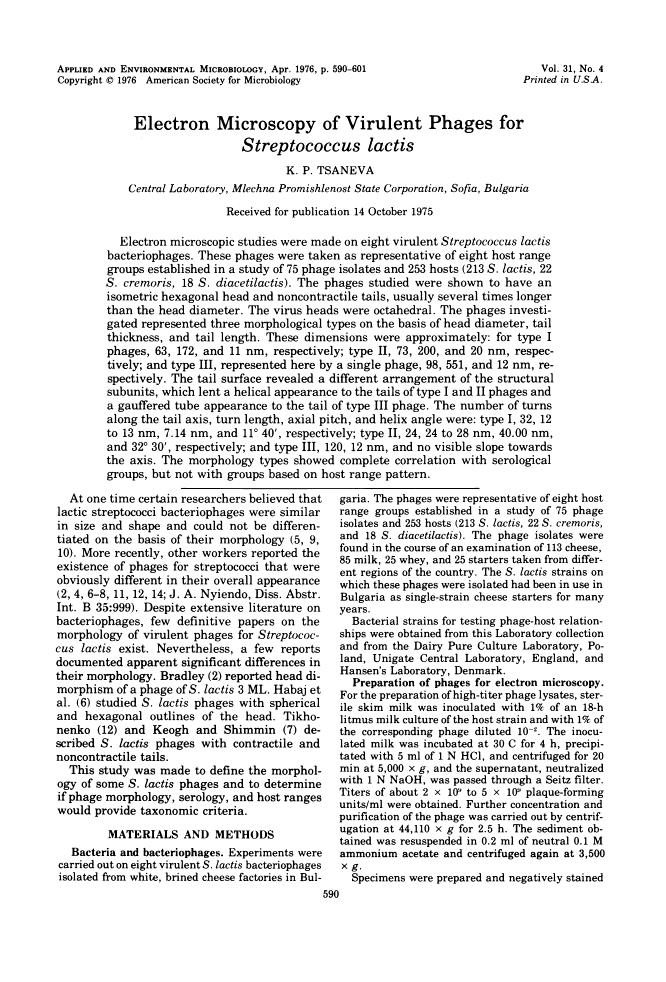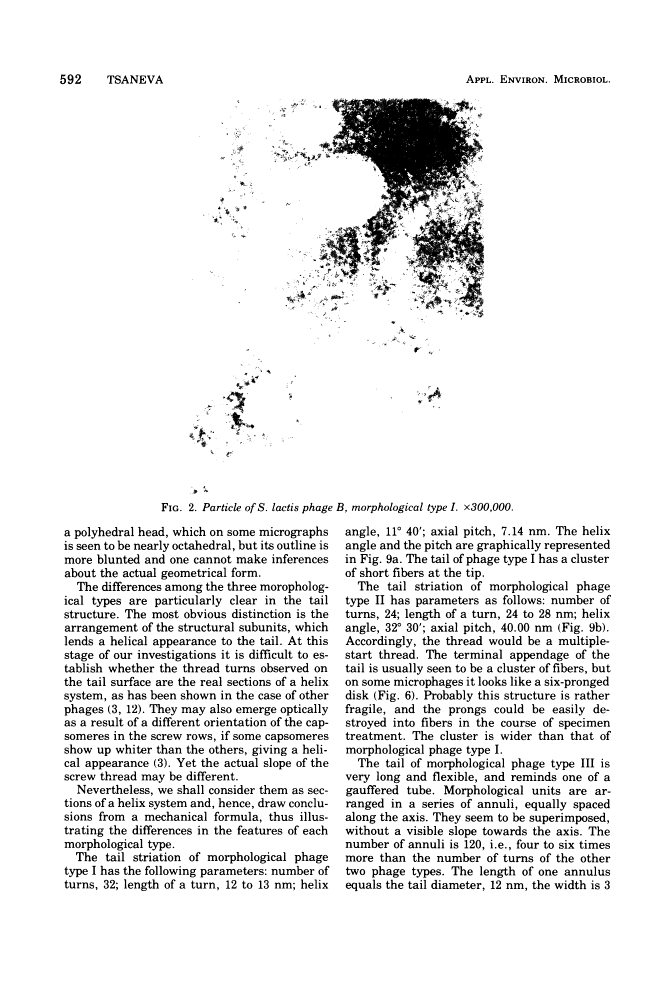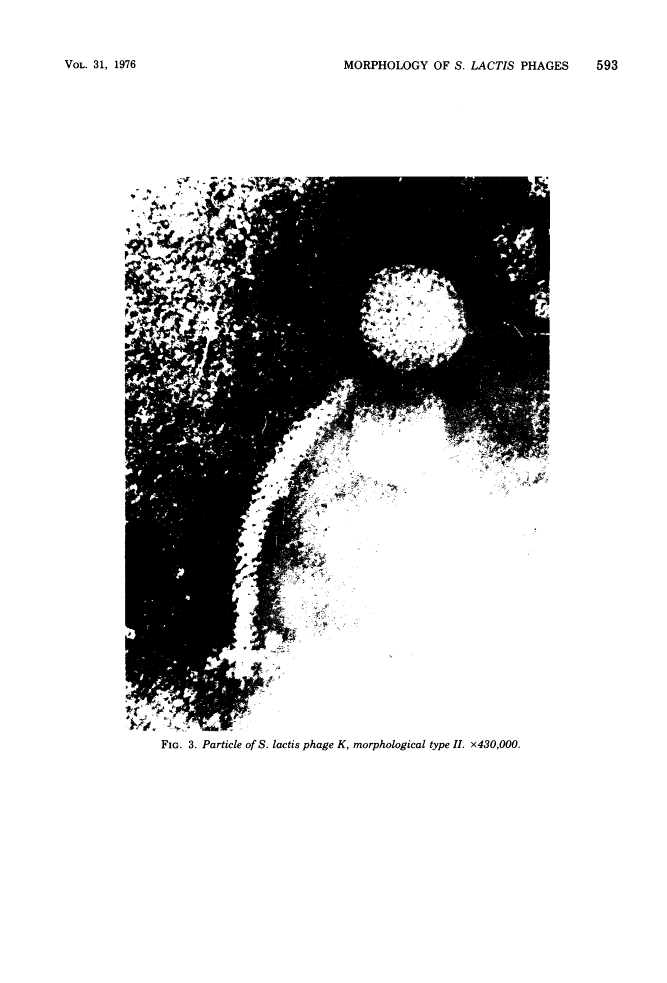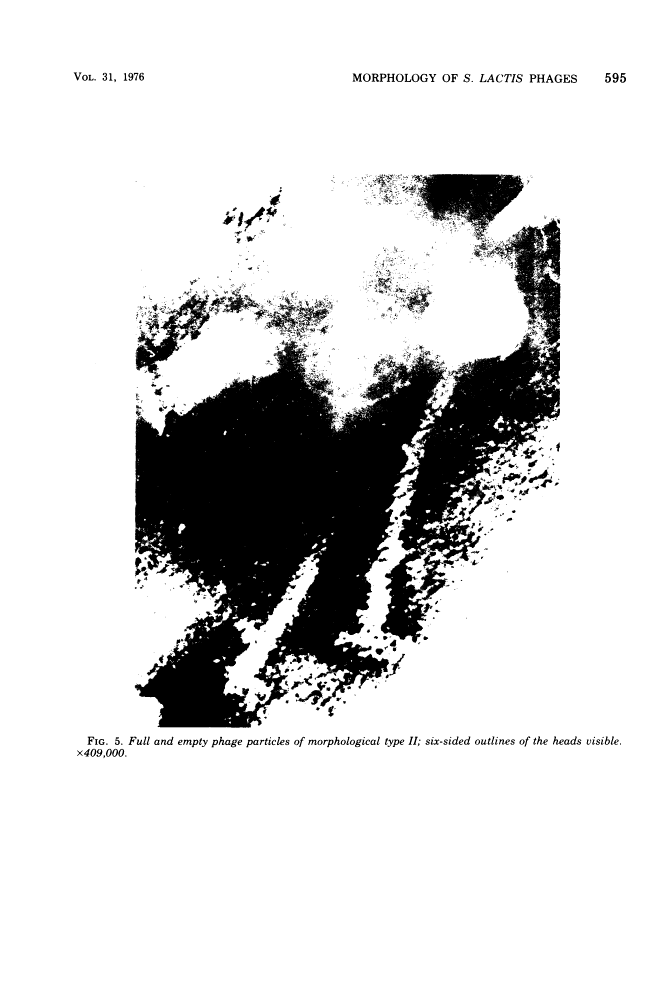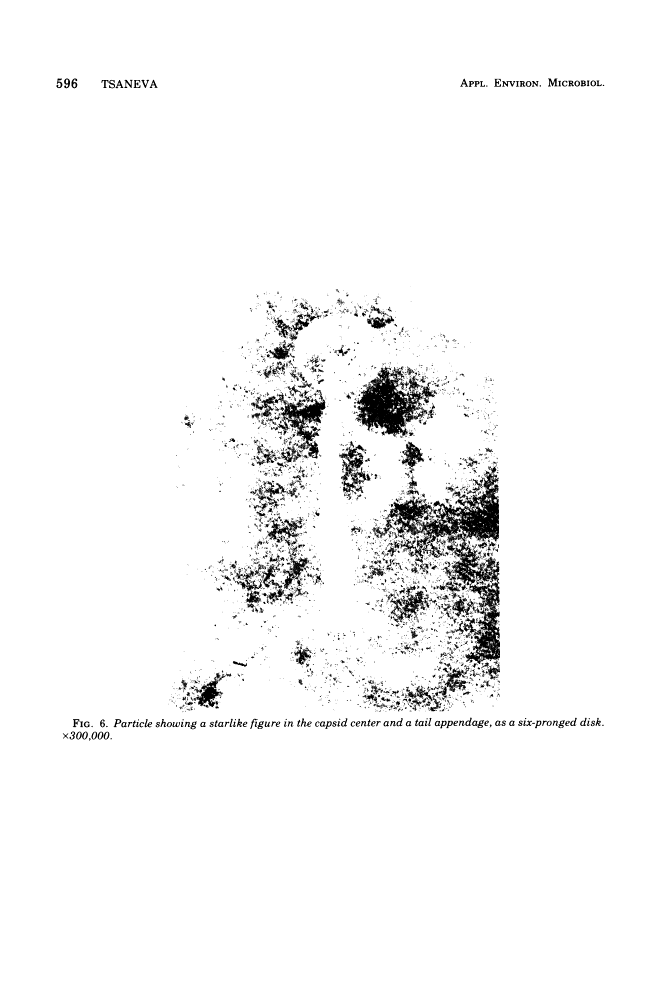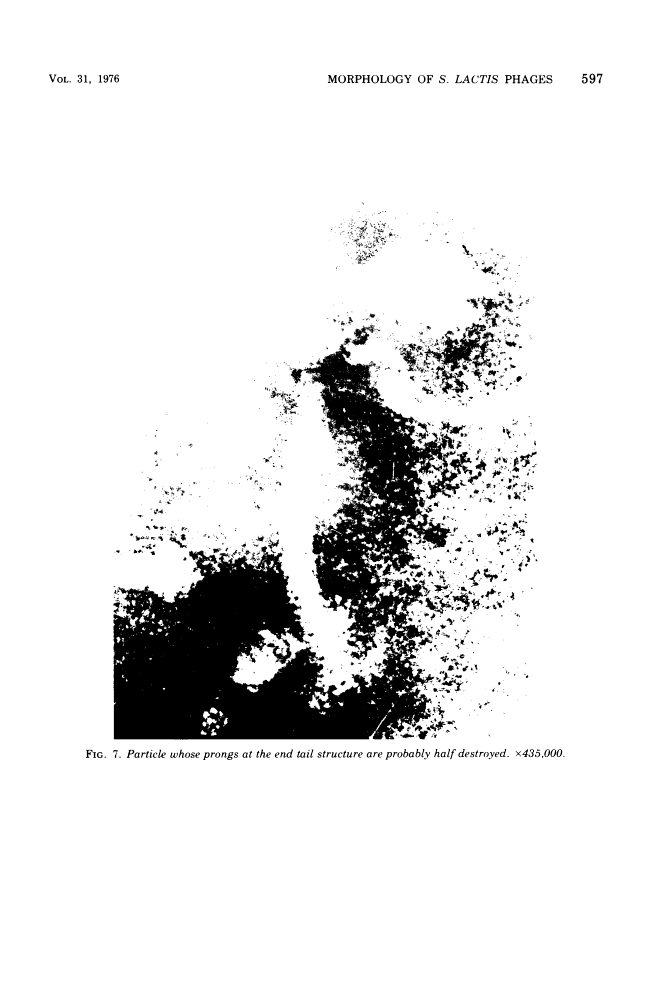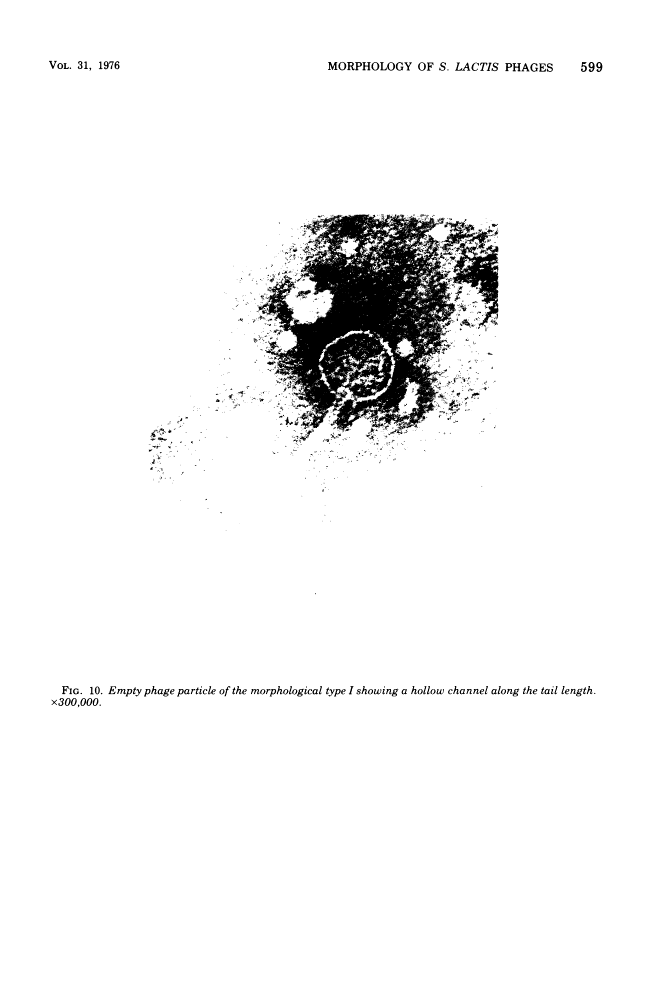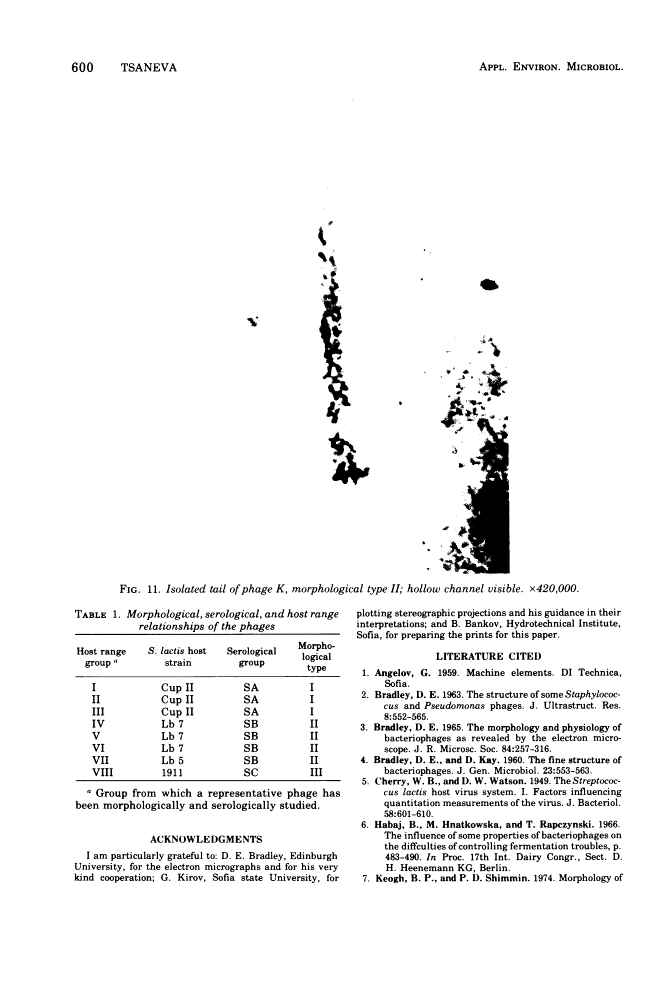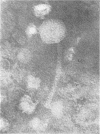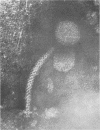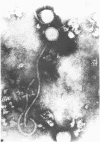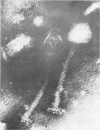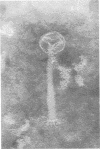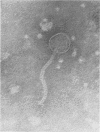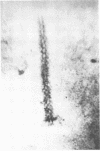Abstract
Free full text

Electron microscopy of virulent phages for Streptococcus lactis.
Abstract
Electron microscopic studies were made on eight virulent Streptococcus lactis bacteriophages. These phages were taken as representative of eight host range groups established in a study of 75 phage isolates and 253 hosts (213 S. lactis, 22 S. cremoris, 18 S. diacetilactis). The phages studied were shown to have an isometric hexagonal head and noncontractile tails, usually several times longer than the head diameter. The virus heads were octahedral. The phages investigated represented three morphological types on the basis of head diameter , tail thickness, and tail length. These dimensions were approximately: for type I phages, 63, 172, and 11 nm, respectively; type II, 73, 200, and 20 nm, respectively; and type III, represented here by a single phage, 98, 551, and 12 nm, respectively. The tail surface revealed a different arrangment of the structural subunits which lent a helical appearance to the tails of type I and II phages and a guaffered tube appearance to the tail of type III phage. The number of turns along the tail axis, turn length, axial pitch, and helix angle were: type I, 32, 12 to 13 nm, 7.14 nm, and 11 degrees 43', respectively; type II, 24, 24, to 28 nm, 40.00 nm, and 32 degrees 30', respectively; and type III, 120, 12 nm, and no visible slope towards the axis. The morphology types showed complete correlation with serological groups, but not with groups based on host range pattern.
Full text
Full text is available as a scanned copy of the original print version. Get a printable copy (PDF file) of the complete article (2.5M), or click on a page image below to browse page by page. Links to PubMed are also available for Selected References.
Images in this article
Click on the image to see a larger version.
Selected References
These references are in PubMed. This may not be the complete list of references from this article.
- BRADLEY DE. The structure of some Staphylococcus and Pseudomonas phages. J Ultrastruct Res. 1963 Jun;8:552–565. [Abstract] [Google Scholar]
- Bradley DE. The morphology and physiology of bacteriophages as revealed by the electron microscope. J R Microsc Soc. 1965 Sep;84(3):257–316. [Abstract] [Google Scholar]
- CHERRY WB, WATSON DW. The Streptococcus lactis host-virus system; factors influencing quantitative measurement of the virus. J Bacteriol. 1949 Nov;58(5):601–illust. [Europe PMC free article] [Abstract] [Google Scholar]
- Keogh BP, Shimmin PD. Morphology of the bacteriophages of lactic streptococci. Appl Microbiol. 1974 Feb;27(2):411–415. [Europe PMC free article] [Abstract] [Google Scholar]
- Parmelee CE, Carr PH, Nelson FE. ELECTRON MICROSCOPE STUDIES OF BACTERIOPHAGE ACTIVE AGAINST STREPTOCOCCUS LACTIS. J Bacteriol. 1949 Apr;57(4):391–397. [Europe PMC free article] [Abstract] [Google Scholar]
- WILLIAMSON KI, BERTAUD WS. A new bacteriophage active against a lactic streptococcus. J Bacteriol. 1951 May;61(5):643–645. [Europe PMC free article] [Abstract] [Google Scholar]
Associated Data
Articles from Applied and Environmental Microbiology are provided here courtesy of American Society for Microbiology (ASM)
Full text links
Read article at publisher's site: https://doi.org/10.1128/aem.31.4.590-601.1976
Read article for free, from open access legal sources, via Unpaywall:
https://aem.asm.org/content/aem/31/4/590.full.pdf
Free after 4 months at aem.asm.org
http://aem.asm.org/cgi/reprint/31/4/590
Free to read at aem.asm.org
http://aem.asm.org/cgi/content/abstract/31/4/590
Citations & impact
Impact metrics
Citations of article over time
Article citations
Isolation of Streptococcus lactis Bacteriophages and Their Interaction with the Host Cell.
Appl Environ Microbiol, 47(6):1352-1354, 01 Jun 1984
Cited by: 2 articles | PMID: 16346573 | PMCID: PMC240245
Ultrastructure and Host Specificity of Bacteriophages of Streptococcus cremoris, Streptococcus lactis subsp. diacetylactis, and Leuconostoc cremoris from Finnish Fermented Milk "Viili".
Appl Environ Microbiol, 52(4):771-777, 01 Oct 1986
Cited by: 20 articles | PMID: 16347170 | PMCID: PMC239112
Bacteriophage Resistance Conferred on Lactic Streptococci by the Conjugative Plasmid pTR2030: Effects on Small Isometric-, Large Isometric-, and Prolate-Headed Phages.
Appl Environ Microbiol, 51(6):1272-1277, 01 Jun 1986
Cited by: 34 articles | PMID: 16347086 | PMCID: PMC239057
Tubular heads in bacteriophages from lactic streptococci.
Appl Environ Microbiol, 45(1):294-296, 01 Jan 1983
Cited by: 2 articles | PMID: 16346173 | PMCID: PMC242268
Transduction of Lactose Metabolism by Streptococcus cremoris C3 Temperate Phage.
Appl Environ Microbiol, 42(5):897-903, 01 Nov 1981
Cited by: 12 articles | PMID: 16345892 | PMCID: PMC244124
Go to all (8) article citations
Similar Articles
To arrive at the top five similar articles we use a word-weighted algorithm to compare words from the Title and Abstract of each citation.
Morphology of the bacteriophages of lactic streptococci.
Appl Microbiol, 27(2):411-415, 01 Feb 1974
Cited by: 16 articles | PMID: 4132690 | PMCID: PMC380044
Ultrastructure and Host Specificity of Bacteriophages of Streptococcus cremoris, Streptococcus lactis subsp. diacetylactis, and Leuconostoc cremoris from Finnish Fermented Milk "Viili".
Appl Environ Microbiol, 52(4):771-777, 01 Oct 1986
Cited by: 20 articles | PMID: 16347170 | PMCID: PMC239112
Incidence and properties of temperate bacteriophages induced from lactic streptococci.
Appl Environ Microbiol, 33(1):184-191, 01 Jan 1977
Cited by: 35 articles | PMID: 402110 | PMCID: PMC170620
Tailed bacteriophages: the order caudovirales.
Adv Virus Res, 51:135-201, 01 Jan 1998
Cited by: 191 articles | PMID: 9891587 | PMCID: PMC7173057
Review Free full text in Europe PMC
